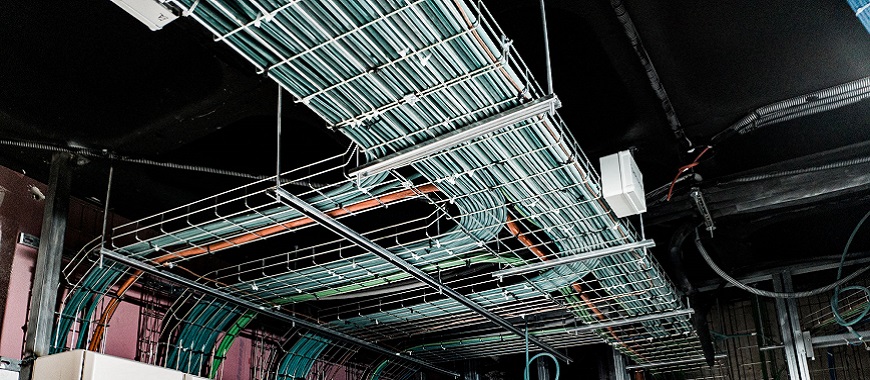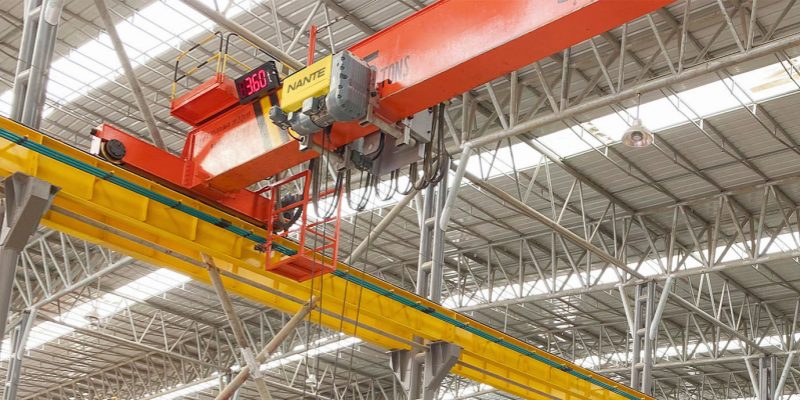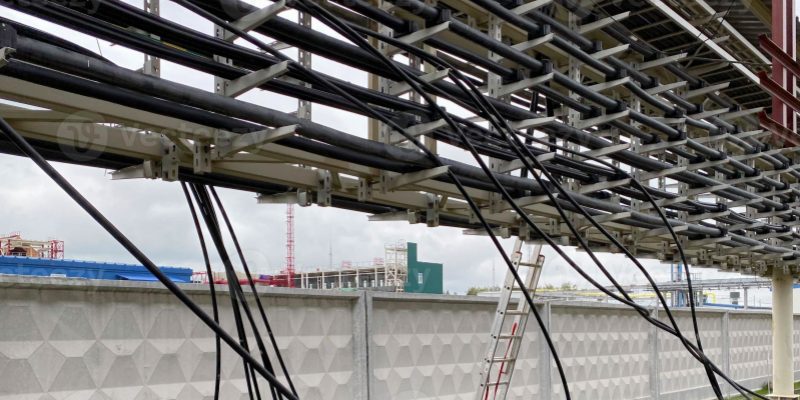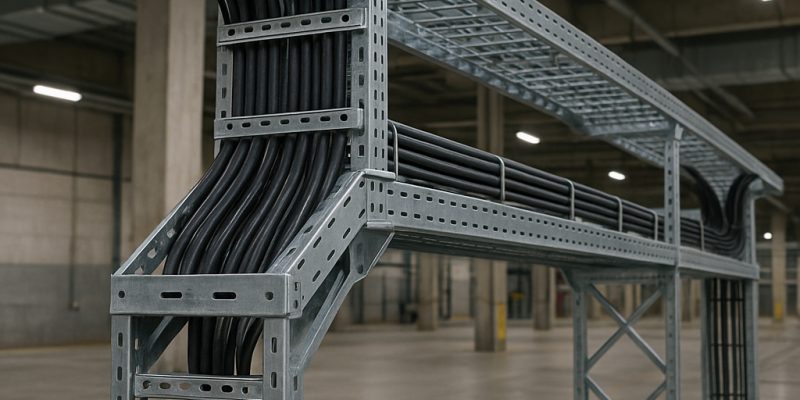
Selecting the right gantry cable tray is crucial in maintaining efficient and secure cable management systems, especially in industrial settings. A gantry cable tray serves as a structured pathway, supporting and organizing various cables while ensuring they remain safe and manageable. These trays are essential for preventing damage, reducing overheating risks, and allowing convenient access for maintenance. Choosing the correct type and size of gantry cable tray is vital to meeting specific operational demands, as different installations may require particular features—such as open ladder trays for ventilation or enclosed trays for EMI/RFI shielding. Understanding the unique functions of each gantry cable tray option helps ensure long-term stability, safety, and effectiveness in any industrial application.
Types of Gantry Cable Trays and Their Applications
A gantry cable tray is essential for structured cable management, particularly in industrial settings requiring robust and organized installations. Choosing the right gantry cable tray and cable tray for gantry systems enables effective organization and protection of cables across various applications. The primary types, such as ladder and enclosed trays, each have unique features, advantages, and ideal usage contexts.
| Tray Type | Key Features | Benefits | Drawbacks | Practical Applications |
|---|---|---|---|---|
| Ladder Cable Tray | Open-rung (9″ spacing), maximum airflow, anchor points | Prevents overheating; supports heavy loads; easy install | No EMI/RFI protection | Overhead cranes; production-line cabling |
| Enclosed Cable Tray | Fully enclosed; EMI/RFI shielding; solid walls | Blocks interference; guards cables from damage | Potential moisture buildup; needs drains | Data centers; medical facilities |
| Gantry Cable Tray for Crane Systems | Spans girders; flexible connections on moving spans | Prevents tangling; weather-resistant options | Requires precise sizing and routing | Port cranes; warehouse gantries |
| Selection & Customization Factors | Material (steel, aluminum, FRP), size, finish options | Optimized cooling/shielding; corrosion resistance | Higher cost and longer lead time | Oil & gas; mining; specialty manufacturing plants |

Top Retractable Cable Tray Options for Office Setups
Gantry Cable Tray Sizes and Customization Options
Selecting the right gantry cable tray size is critical for effective cable management in industrial and crane applications. The correct size ensures safe cable handling, reduces wear, and prevents overheating. Additionally, customization options provide flexibility for environments with unique challenges, allowing gantry cable trays to fit specific setups, cable volumes, and installation needs.
Importance of Selecting the Right Gantry Cable Tray Size
Choosing an appropriate gantry cable tray size for gantry applications offers several benefits:
- Safety and Reliability: Ensures stable cable support, preventing accidental sagging or tangling, which could damage cables or cause hazards.
- Reduced Maintenance: Properly sized gantry cable trays minimize wear on cables, leading to fewer maintenance issues and longer cable life.
- Cost-Efficiency: Avoids the costs associated with oversized or undersized trays, optimizing space and material usage.
Without the correct size, a cable tray for gantry setups may fail to provide adequate support, leading to increased risks and operational inefficiencies.
Advantages of Customizing Gantry Cable Tray Sizes
Customization options allow gantry cable trays to meet specific industrial needs, from load capacity to environmental resilience. Custom trays ensure compatibility with unique operational requirements and promote efficiency.
Benefits of Customized Gantry Cable Trays
Customized gantry cable trays can offer advantages over standard sizes, such as:
- Enhanced performance: Optimized for the exact cable volume and layout, reducing strain on cables.
- Durability: Materials and finishes can be tailored to resist specific environmental challenges.
- Space efficiency: Designed to fit precisely within a specific area, maximizing space usage.
Examples of Customization Options
Examples of customizable options for gantry cable trays include:
- Variable rung spacing: Allows for optimal support based on cable size and weight requirements.
- Material selection: Options like aluminum, stainless steel, or composite materials provide resistance to specific environmental factors.
- Special coatings: Protective coatings add corrosion resistance, ideal for harsh outdoor or chemical-heavy environments.
Case Studies: Successful Applications of Customized Gantry Cable Tray Sizes
Customized gantry cable trays have proven beneficial in various industrial environments. Some successful applications include:
- Manufacturing plants: Facilities with complex machinery layouts use custom-sized trays to fit around equipment, ensuring secure cable paths.
- Shipping ports: Custom trays accommodate the unique layouts of port cranes, protecting cables from outdoor elements.
- Chemical processing facilities: Corrosion-resistant trays ensure safety in environments with high exposure to chemicals.
Selecting the right gantry cable tray size and considering customization options is essential for safe and effective cable management in industrial and crane applications. By evaluating factors such as weight capacity, environmental exposure, and installation requirements, industries can ensure long-lasting, reliable, and cost-effective cable management systems tailored to their specific operational needs.
Elevate Interior Design with Decorative Cable Tray Options
Gantry Cable Tray for Sale: Choosing Reliable Options
When selecting a gantry cable tray for industrial use, focusing on quality and reliability is essential for safe and durable cable management. Industrial settings often expose cable trays to heavy loads, environmental stressors, and high traffic, making it crucial to choose gantry cable trays that meet safety standards and quality benchmarks. In particular, an exposed cable tray setup can be especially susceptible to damage if not properly designed or installed. Here, we explore key considerations for purchasing gantry cable trays and discuss quality checks and safety standards that ensure long-lasting and secure installations.
Material Selection
The material of a cable tray for gantry applications directly affects its durability, weight capacity, and corrosion resistance. Various materials offer specific advantages:
- Steel: Provides excellent strength and load-bearing capacity, suitable for heavy-duty applications.
- Aluminum: Lightweight and corrosion-resistant, ideal for environments with minimal load requirements.
- Fiberglass: Non-corrosive and suitable for settings exposed to chemicals or moisture, though it may have lower load capacity.
Load Capacity
Selecting a gantry cable tray that can handle the weight of all cables, plus any potential future additions, is critical. Considerations include:
- Current and future cable weight: Ensure that the tray can support not only present cables but also possible future additions.
- Tray size: Larger trays generally accommodate higher loads, while smaller trays may be better suited for light-duty applications.
Environmental Conditions
Environmental factors significantly influence the performance of a gantry cable tray. Assess these elements based on the specific setting:
- Outdoor or indoor installation: Outdoor trays require weather-resistant materials, while indoor trays may not need this feature.
- Moisture and chemical exposure: Areas with exposure to chemicals, moisture, or high humidity benefit from corrosion-resistant materials.
- Temperature extremes: Environments with significant temperature fluctuations require materials that can withstand expansion and contraction without damage.
Installation Requirements
The installation process can vary based on the design and layout of a cable tray for gantry setups, requiring a solid grasp of installation basics and specialized mounting techniques. Important factors include:
- Ease of access: Choose a tray that allows for easy installation and maintenance access.
- Mounting options: Select trays with mounting systems that align with the structure of the industrial setting, whether wall-mounted or floor-mounted.
- Customizability: Trays with customizable features, such as adjustable supports, can be adapted to specific layout constraints.

Benefits of Gantry Cable Tray
Gantry cable trays are essential for industrial operations, delivering enhanced safety, reduced maintenance, and extended service life. Engineered for demanding environments, they perform core cable tray function—routing, supporting, and protecting cables—to streamline management and safeguard critical power and data lines. The following sections examine key benefits in detail.
Increased Safety
Gantry cable trays significantly enhance workplace safety by minimizing the risk of cable damage or detachment. Their robust design and secure mounting features prevent stray or sagging cables that can create tripping hazards or electrical faults. By ensuring cables remain firmly in place under dynamic loads and harsh conditions, these trays reduce the likelihood of accidents and unplanned shutdowns. This integrity fosters a safer operational environment for personnel.
Reduced Maintenance
Gantry cable trays substantially lower maintenance requirements by resisting corrosion, wear, and mechanical damage. Constructed from durable materials like galvanized steel or aluminum alloys, these trays maintain structural integrity under heavy loads and environmental stressors. Their robust coating and seamless construction inhibit rust and degradation, reducing the frequency of inspections, repairs, or part replacements. As a result, maintenance teams can allocate resources more efficiently, lowering downtime and operational costs.
Longevity
Gantry cable trays offer exceptional longevity by withstanding industrial stressors such as vibration, heavy loads, and corrosive environments. Their high-strength construction and weather-resistant finishes prevent structural fatigue and material degradation over prolonged periods. By leveraging premium-grade materials and precision engineering, these trays maintain their load-bearing capacity and appearance even under constant use. This long service life maximizes return on investment and minimizes the need for full-system replacements.
Enhanced Operational Efficiency
Gantry cable trays streamline industrial workflows by providing organized routing and easy access to cables, reducing installation and modification times. Their modular design allows quick configuration changes when production layouts evolve or equipment is relocated. By minimizing cable clutter and ensuring predictable pathways, these trays facilitate faster troubleshooting and upgrades. As a result, plant managers experience improved operational efficiency and can adapt systems swiftly to meet changing production demands.
Superior Cable Organization
Gantry cable trays enhance cable organization by grouping and separating power, data, and control lines within dedicated channels. This separation minimizes electromagnetic interference and simplifies labeling, documentation, and routing verification. Clear cable pathways reduce the risk of accidental disconnections during maintenance or reconfiguration. Additionally, neatly organized cables improve the aesthetic and operational clarity of industrial installations, aiding compliance with safety standards and making audits more straightforward.
Real-World Applications of Gantry Cable Trays
Gantry cable trays deliver robust and adaptable cable management across diverse industrial settings. By choosing the right materials and configurations, these trays improve safety, durability, and operational efficiency. The following sections showcase their real-world applications in manufacturing facilities, outdoor crane systems, chemical plants, oil & gas refineries, and data centers.
Manufacturing Facilities
In manufacturing facilities, gantry cable trays organize extensive power and signal networks across production lines. Their modular construction allows rapid reconfiguration when machinery layouts change, minimizing downtime during upgrades. The trays’ durable materials withstand mechanical stresses from hoists, conveyors, and robotic arms. By keeping cables neatly routed and elevated, these systems reduce tripping hazards and simplify inspections. Maintenance crews benefit from clear access, accelerating troubleshooting and part replacement to sustain continuous, high-volume output.
Outdoor Crane Systems
Outdoor crane systems rely on gantry cable trays engineered for exposure to sun, rain, and wind. Corrosion-resistant finishes, such as hot-dip galvanizing or powder coatings, protect both power and control cables from environmental damage. Flexible support sections accommodate trolley and bridge movements without strap fatigue or tangling. Properly selected trays maintain signal integrity and uninterrupted power delivery, ensuring that loading and unloading operations at ports, terminals, and construction sites proceed safely and without unplanned stoppages.
Chemical Plants
In chemical plant environments, gantry cable trays fabricated from fiberglass-reinforced plastic (FRP) or stainless steel resist corrosive agents and moisture. These non-conductive materials prevent chemical interactions that could degrade tray structure or cable insulation. Trays installed above reaction vessels, pipelines, and storage areas provide secure routing pathways for instrumentation and control cables. By maintaining strict separation from corrosive atmospheres, these systems safeguard signal accuracy and power delivery, reducing the risk of equipment failure and costly production shutdowns.
Oil & Gas Refineries
In oil & gas refineries, gantry cable trays must endure extreme temperatures, explosive atmospheres, and chemical exposure. Trays often feature specialized coatings and explosion-proof fittings to comply with strict safety regulations. They route power, control, and instrumentation cables along distillation columns, skids, and flare stacks, maintaining essential process monitoring and emergency shutdown capabilities. Robust tray design and secure fastenings prevent cable strain under vibration and thermal cycling, ensuring uninterrupted operations in mission-critical facilities.
Data Centers
Data centers leverage gantry cable trays to manage dense bundles of network and power cables across server aisles and overhead racks. The trays’ open design promotes efficient airflow, aiding in temperature control and reducing cooling costs. Structured tray layouts separate high-voltage power lines from sensitive data runs, minimizing electromagnetic interference. Modular tray sections support rapid equipment roll-outs and reconfigurations, enabling data centers to scale capacity without compromising cable integrity or accessibility for maintenance teams.

Durable Flat Cable Tray for Efficient Cable Management
National Standards and Safety Requirements for Gantry Cable Tray Installation
At GangLong Fiberglass, we understand the importance of adhering to national standards and safety requirements when installing gantry cable trays. These guidelines ensure that our gantry cable trays not only meet quality standards but also provide safe, effective cable management in various environments. Here, we’ll cover the relevant standards, including the National Electrical Code (NEC) and specific requirements for different tray types and applications.
Overview of National Standards for Gantry Cable Tray Installation
National standards like the NEC outline the basics and techniques of safe installation practices for gantry cable trays. These codes help establish parameters for safe usage, load handling, and effective support for electrical systems. By complying with these standards, GangLong Fiberglass guarantees that our gantry cable tray installations meet or exceed industry expectations.
Key standards include:
- National Electrical Code (NEC): Provides guidelines for all cable tray systems, covering structural integrity, load capacity, grounding, and spacing.
- OSHA Regulations: OSHA standards contribute to workplace safety, particularly in high-traffic and industrial environments where secure cable management is essential.
- IEC Standards: For international applications, IEC standards ensure that gantry cable trays comply with global safety and performance criteria.
NEC Requirements for Gantry Cable Tray Types
The NEC specifies distinct requirements for various gantry cable tray types, including ladder trays and enclosed trays. These requirements ensure that each tray type supports cables effectively while minimizing risks.
Ladder Tray Requirements
Ladder trays, also known as cable ladder systems, are among the most widely used gantry cable tray types in industrial environments, offering efficient support and ventilation. NEC requirements for ladder trays focus on aspects such as:
- Spacing and Support: Ladder trays must have adequate spacing between rungs to allow airflow and prevent overheating. Standard rung spacing typically measures 9 inches.
- Grounding: Proper grounding of ladder trays is essential to reduce electrical hazards.
- Load Capacity: NEC specifies that ladder trays must support all cable loads, including potential future additions, without sagging or compromising structural integrity. This directly relates to cable tray loading, which ensures that trays are designed to safely handle the weight of the cables they are meant to carry.
Enclosed Tray Requirements
Enclosed gantry cable trays provide EMI/RFI protection, making them suitable for environments with high levels of electromagnetic interference. NEC guidelines for enclosed trays include:
- EMI/RFI Shielding: Enclosed trays must offer sufficient shielding to prevent interference with sensitive equipment.
- Drainage Provisions: Since enclosed trays may accumulate moisture, they require proper drainage to prevent damage.
- Material Standards: The NEC mandates corrosion-resistant materials in trays exposed to moisture, ensuring long-term reliability.
Gantry Cable Tray Installation in Hazardous Environments
In hazardous environments, specific guidelines apply to the installation of gantry cable trays to ensure safety and durability. GangLong Fiberglass considers these requirements vital for operations where exposure to chemicals, extreme temperatures, or flammable substances is common.
Requirements for Hazardous Locations
The NEC has specific provisions for cable tray installations in hazardous locations to prevent risks associated with flammable gases, dust, and other dangerous materials. Key requirements include:
- Class II, Division 2 Standards: In environments classified as Class II, Division 2, the NEC restricts the use of solid-bottom trays. Only ladder or ventilated trays are allowed, minimizing the risk of overheating or moisture buildup. This requirement ties into the broader concept of cable tray risk assessment, which considers environmental factors that could compromise tray performance and safety.
- Corrosion Resistance: In areas with corrosive chemicals, trays must be constructed from materials that can resist deterioration and protect cables.
- Temperature Tolerance: Trays in high-temperature zones must maintain structural integrity under extreme heat to prevent cable damage.
Importance of Compliance in Hazardous Environments
Complying with NEC standards in hazardous settings ensures safety for personnel and equipment. By choosing GangLong Fiberglass, clients benefit from our commitment to meeting or exceeding all applicable standards, providing peace of mind in even the most challenging environments.
Additional Safety Standards for Gantry Cable Tray Installation
At GangLong Fiberglass, we don’t just follow NEC guidelines; we also prioritize additional safety standards that enhance the reliability and longevity of our gantry cable tray installations.
Additional safety measures we follow include:
- OSHA Standards: OSHA standards provide essential guidelines for safe installations, particularly in high-traffic industrial areas.
- NEMA Ratings: For installations requiring specific environmental protections, NEMA ratings help identify trays designed to withstand water, dust, or other conditions.
- IEC Standards: For international projects, IEC standards ensure that our gantry cable trays meet global safety requirements.
Meeting national standards and safety requirements for gantry cable tray installations is crucial in industrial environments. At GangLong Fiberglass, we strictly adhere to NEC guidelines for ladder trays, enclosed trays, and hazardous locations, providing secure and reliable cable management solutions. By focusing on quality and safety, we ensure that each gantry cable tray installation offers effective performance, protecting both equipment and personnel.
FAQs about Gantry Cable Tray
The three main types of cable trays are ladder trays, ventilated trough trays, and solid-bottom trays. Each type has unique applications and benefits. Ladder trays feature open rungs, allowing for maximum airflow, which helps prevent cable overheating. This type is ideal for industrial settings with heavy cable loads. Ventilated trough trays, on the other hand, have a partially enclosed design with small openings along the sides and bottom. They offer more support than ladder trays, making them a good choice for lighter cables in aesthetic setups. Solid-bottom trays provide complete enclosure, protecting cables from external elements. This type is frequently used in environments requiring EMI or RFI shielding. Solid-bottom trays may need extra drainage to manage moisture buildup. Choosing the correct tray type depends on factors like environment, cable type, and ventilation needs.
The primary difference between a cable tray and a ladder tray lies in their design and functionality. A cable tray is a broad term that includes various styles, such as ladder, ventilated trough, and solid-bottom trays, each serving different applications. A ladder tray, specifically, has an open, ladder-like structure with spaced rungs. This design maximizes airflow around cables, helping to disperse heat and prevent overheating. Ladder trays are particularly useful in industrial settings where high volumes of cables generate significant heat. In contrast, other types of cable trays may provide more enclosure for additional protection or aesthetic purposes. Thus, while all ladder trays are cable trays, not all cable trays are ladder trays. Each type has unique strengths depending on the specific requirements of the cable installation.
Cable trunking and cable trays serve different purposes in cable management, primarily differing in design and application. Cable trunking is a fully enclosed system, typically featuring a lid that completely surrounds the cables. This setup provides protection from dust, moisture, and other environmental factors, making it suitable for areas where aesthetics or protection from physical damage are priorities. Cable trays, by contrast, are open or partially open structures used to support large numbers of cables. They are typically used in industrial or commercial environments where ventilation and ease of access are essential. Unlike trunking, cable trays allow for better heat dissipation, making them ideal for installations with high-power cables. Ultimately, trunking is more suitable for enclosed protection, while cable trays offer efficient support and ventilation in high-capacity cable setups.
Cable trays and cable buses both support electrical cables but differ in structure, design, and use. A cable tray is an open structure used to carry and organize multiple cables along a support path. It is ideal for environments where cable flexibility and ventilation are necessary, as trays allow airflow to prevent overheating. Cable trays are also easier to access for maintenance and modifications. In contrast, a cable bus is a fully enclosed system with insulated conductors held in a protective enclosure, often used for large power distribution over short distances. The cable bus offers superior protection from physical and environmental damage but lacks the flexibility of cable trays. While cable trays are common in general wiring installations, cable buses are mainly used in power plants, substations, and facilities needing compact, high-power cable transmission.

As the editor of GangLong Fiberglass, I have years of experience and in-depth research, focusing on cable tray products, fiberglass solutions, and grille systems. I incorporate years of industry insights and practical experience into every content, committed to promoting the progress of the industry. At GangLong Fiberglass, my commitment is reflected in every product, from innovative cable trays to durable fiberglass solutions and sturdy grille systems. As an authoritative voice in the industry, my goal is to provide valuable information to professionals and businesses and promote forward-looking solutions.


